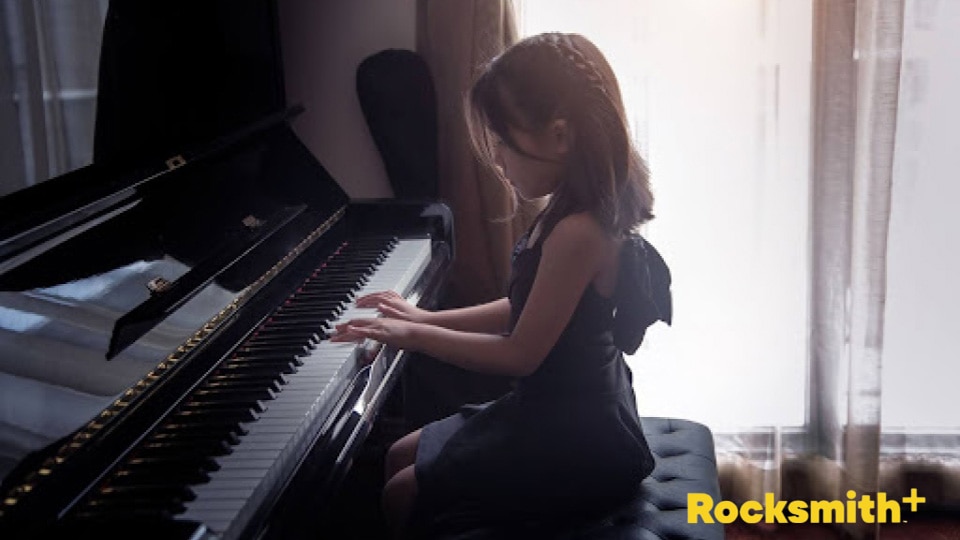Learning to play the piano is a journey of melody, creativity, and personal expression. It's a timeless instrument that offers joy, challenges, and rewards in equal measure. As with any journey, the first step is often the most crucial, and for aspiring pianists, this step begins with understanding the keyboard and its notes.
In this guide, we will delve deep into the basics of the piano keyboard, demystify music notes, set you on the path to playing your first songs, and learn how Rocksmith+ can help you start and continue your musical journey.
What Are the Basics of Playing the Piano?
The layout of a piano, whether you're sitting in front of an acoustic grand piano or a compact digital keyboard, is designed with logic and symmetry that makes it easier for beginners to grasp.
White Keys
These are the foundational keys on a piano, representing the natural notes. As you look at the keyboard, you'll notice these white keys are named after the first seven letters of the alphabet: A, B, C, D, E, F, and G. After G, the sequence starts over from A.
Particularly important is the "Middle C" - a landmark note for beginners. This key is located roughly in the center of the keyboard. It serves as a reference point for identifying other notes and understanding the difference between the right and left-hand sections of the keyboard.
Black Keys
![[RS+] Piano Notes for Beginners: Understand the Keyboard SEO ARTICLE - black keys](http://staticctf.ubisoft.com/J3yJr34U2pZ2Ieem48Dwy9uqj5PNUQTn/77tF5fijmOWoFbVADOEJK9/e43d3e2539041666d2c7611c380e92aa/22.jpg)
The black keys represent sharps and flats and are nestled between some of the white keys. They are always in sets of twos and threes.
When a black key is to the right of a white key, it's a sharp (#), and when it's to the left, it's a flat (♭). For instance, the black key to the right of an A is A#, and to the left of a B, it's B♭.
![[RS+] Piano Notes for Beginners: Understand the Keyboard SEO ARTICLE - left hand right hand](http://staticctf.ubisoft.com/J3yJr34U2pZ2Ieem48Dwy9uqj5PNUQTn/21yYYoE0gNkzOeQwLKVckg/ea03c0802791d46dee66a0d40f39f9a2/33.jpg)
Left Hand vs. Right Hand
While the piano doesn't strictly divide notes for left and right hands, generally, the deeper-sounding notes (lower notes) to the left are played with the left hand, and the brighter-sounding notes (higher notes) to the right are played with the right hand. This division assists in understanding bass and treble clefs, which we'll delve into shortly.
Note Values
Music is a language, and each note has a distinct duration or the played length. The whole note, represented by a hollow oval, is often the longest duration in standard pieces. It's followed by the half note, which is half the duration of a whole note.
The quarter note is one-fourth the duration of the whole note and is followed by the eighth note. As you delve deeper, you'll come across even shorter notes, but for beginners, these are essential to start with.
Time Signatures
Ever tapped your foot to the beat of a song? That's rhythm, and it's governed by something called a time signature.
Placed at the beginning of sheet music, it consists of two numbers, one on top of the other. The top number tells you how many beats there are in a measure, and the bottom number tells you the value of each beat.
For instance, a 4/4 time signature, commonly called "common time," means there are four beats in a measure, and each beat has the value of a quarter note.
Ledger Lines, Lines, and Spaces
When you start to read sheet music, you'll notice it's made of lines and spaces. Notes can either be placed on a line or in a space.
Ledger lines act as short extensions when notes go beyond the main set of lines. The position of a note (whether on a line or in a space) tells you its pitch, or in simpler terms, which key to press on the piano.
![[RS+] Piano Notes for Beginners: Understand the Keyboard SEO ARTICLE - ledger lines](http://staticctf.ubisoft.com/J3yJr34U2pZ2Ieem48Dwy9uqj5PNUQTn/5b9HP8AOL9zT2gDMrZuUS0/ff06c2a21b2bc564b9206bb70c68bda1/44.png)
As you familiarize yourself with these fundamental concepts, you'll find that the vast world of music starts to become a little more approachable, one note at a time.
How Do You Read Piano Sheet Music?
![[RS+] Piano Notes for Beginners: Understand the Keyboard SEO ARTICLE - how do you read](http://staticctf.ubisoft.com/J3yJr34U2pZ2Ieem48Dwy9uqj5PNUQTn/5hfm1I3KHMBysUikbWiez7/253da442fb07e341540b4298e7e9c83f/55.jpg)
Unlocking the language of sheet music is your gateway to playing any song on the piano. It's the map that directs your fingers to craft melodies and harmonies.
Let's break down the essentials:
Grand Staff
Sheet music is usually written on a grand staff --- a combination of treble and bass clefs. The treble clef, which looks like a fancy "G," is used for notes typically played with the right hand.
![[RS+] Piano Notes for Beginners: Understand the Keyboard SEO ARTICLE - grand staff](http://staticctf.ubisoft.com/J3yJr34U2pZ2Ieem48Dwy9uqj5PNUQTn/3SXhFW78ZdnlHtyfnuHdTi/4265a959f36af3e149f86e516950d470/66.jpg)
The bass clef, resembling a backward "C," governs the notes for the left hand. As you progress, you'll see that some notes can be played interchangeably with both hands --- for example, the two E ledger lines in the bass clef are the same E as the first line in the treble clef. As a general rule, though, treble is for the right, and bass is for the left.
Key Signatures
![[RS+] Piano Notes for Beginners: Understand the Keyboard SEO ARTICLE - key signatures](http://staticctf.ubisoft.com/J3yJr34U2pZ2Ieem48Dwy9uqj5PNUQTn/5DXpSxm4pWLn3I91QkRS8S/b425a24a2d30c9e9b1df62d91a7aa33a/77.png)
On the left side of your sheet music, right after the clefs, you might notice a series of sharps (#) or flats (♭). This is the key signature, which informs the musician about the scale or mood of the piece. For example, a song in the key of "C major" won't have any sharps or flats, but a "F major" song will have one flat.
Sight Reading
It's the skill of playing a piece of music for the first time just by reading the sheet music. This might seem daunting initially, but with practice, your reading skills will improve, and you'll be able to translate the notes on the page to the keys on the piano more fluidly.
Remember, the more you practice, the better you get! To read music more efficiently, consider these tips:
-
Familiarize yourself with note names and their placements.
-
Regularly practice scales to understand key signatures better.
-
Take it slow. It's okay to play at a slower tempo when starting out. Accuracy before speed!
-
Make a habit of scanning the entire piece briefly before playing the song.
What Are Some Fundamental Music Theory Concepts for Piano?
Behind the beauty of every song is the science of music theory. While the subject is vast, understanding its basics can significantly enhance your piano-playing experience.
Piano Chords
Chords are multiple notes played simultaneously, creating harmony. To begin, try learning the basic major and minor chords, such as C major, which consists of the notes C, E, and G played together.
Half Steps and Whole Steps
![[RS+] Piano Notes for Beginners: Understand the Keyboard SEO ARTICLE - half steps whole steps](http://staticctf.ubisoft.com/J3yJr34U2pZ2Ieem48Dwy9uqj5PNUQTn/2qxWNDLFgS2vG42Jvdchyc/cee8687b0b6cd7b4bd6e63884aa46b7b/unnamed__1_.png)
On the piano, the shortest distance between two notes is a half step, like from a white key to its neighboring black key or vice versa. Two half steps make a whole step. Grasping this concept is crucial when learning scales and chords.
Bar Lines
![[RS+] Piano Notes for Beginners: Understand the Keyboard SEO ARTICLE - bar lines](http://staticctf.ubisoft.com/J3yJr34U2pZ2Ieem48Dwy9uqj5PNUQTn/1pFmwPNBUjp991v4c418RG/71ae93dc99b5f9108fcf3156cf568bc0/unnamed__2_.png)
These vertical lines you see on sheet music divide it into measures. They help organize the music and are crucial when understanding rhythm and time signatures.
Note Reading
As you advance, you'll realize that quickly recognizing each note's letter name is essential. It bridges the gap between seeing a note on the sheet music and playing it on the piano. Consistent practice is the key to mastering this skill.
How To Find Middle C and Beyond
Middle C is like the North Star for pianists --- a reference point from which all other notes can be navigated.
Locating Middle C
Look for the group of two black keys near the center of your piano keyboard. Middle C is the white key immediately to the left of this pair. This note is a great starting point for beginners because many simple pieces are centered around it.
Expanding from Middle C
To its right, you'll venture into notes typically played with the right hand and represented in the treble clef. Going left, you'll encounter the bass clef territory, played mainly with the left hand. Familiarize yourself with the surrounding keys and their note names to expand your playing range.
Taking the Leap: From Beginner to Pro
![[RS+] Piano Notes for Beginners: Understand the Keyboard SEO ARTICLE - taking the lean](http://staticctf.ubisoft.com/J3yJr34U2pZ2Ieem48Dwy9uqj5PNUQTn/5yVFXK1nzD27MSlc6nQQIc/6e1c9a1af1b8e992761478def9dca1ee/99.jpg)
While grasping the basics is essential, learning the piano is a lifelong journey.
Don't restrict yourself. From pop to jazz, classical to contemporary --- the world of piano songs is vast. Exploring different genres will enrich your playing style and musical appreciation.
Take advantage of online resources. Many step-by-step tutorials cater to intermediate and advanced learners. These lessons can help you master more complex pieces and techniques.
As mentioned before, it's crucial. The more you practice, the faster and more accurately you can play a piece just by looking at its sheet music.
Regular time set aside for practice or lessons provides structure, discipline, and professional guidance. This can spotlight your strengths, help rectify mistakes, and fine-tune your skills.
Express Yourself in Music
The piano world is vast and deeply rewarding. As you delve deeper, you'll discover that every key has its story, chord, emotion, and song is a world of its own.
The journey from tapping the first time on a white key to producing soulful melodies is undoubtedly challenging, but every moment is worth its weight in gold. So, keep those fingers dancing, and let your heart sing with every note.
As you advance through learning piano and start playing your favorite songs, consider Rocksmith+ as your lifelong music partner, allowing you to learn and play a wide range of genres and styles, from classical piano to modern songs.
Sources:
Where Is Middle C? (Various Instruments, Explained Simply) | Producer Hive









